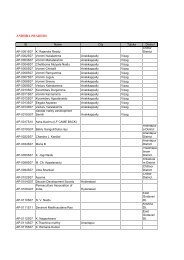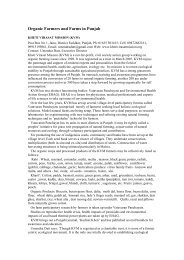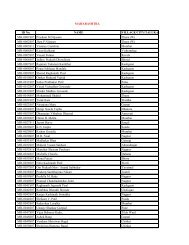Western Ghats Kokum Foundation - Organic Farming Association of ...
Western Ghats Kokum Foundation - Organic Farming Association of ...
Western Ghats Kokum Foundation - Organic Farming Association of ...
You also want an ePaper? Increase the reach of your titles
YUMPU automatically turns print PDFs into web optimized ePapers that Google loves.
acid synthesis, lipogenesis, food intake and induces weight loss. Garcinol, a<br />
polyisoprenylated benzophenone purified from G. indica fruit rind, displays antioxidant,<br />
anti-cancer and anti-ulcer properties. Apart from HCA and garcinol, kokum contains other<br />
compounds with potential antioxidant properties. These include citric acid, malic acid,<br />
polyphenols, carbohydrates, anthocyanin pigments and ascorbic acid<br />
Though studies have been carried out on the antioxidant activities <strong>of</strong> these two<br />
isolated components from G. indica, besides an organic extract, the antioxidant activity <strong>of</strong><br />
the rind and its various preparations as is being used in cooking, in s<strong>of</strong>t drinks and<br />
medicinal preparations has not been evaluated. The levels <strong>of</strong> antioxidant action studied<br />
are (i) radical formation by Ferric Reducing/Antioxidant Power (FRAP); (ii) radical<br />
scavenging by Oxygen Radical Absorbance Capacity (ORAC) and 2,2¢-azobis-3ethylbenzthiazoline-6-sulphonic<br />
acid (ABTS), and (iii) prevention <strong>of</strong> membrane damage as<br />
measured by lipid peroxidation.<br />
These are standard assays used for determining the antioxidant abilities <strong>of</strong> food<br />
preparations. The aqueous and boiled extracts were prepared so as to simulate conditions<br />
<strong>of</strong> their extraction pertaining to their use for cooking purposes. The aqueous extract was<br />
prepared by adding the crushed rind to distilled water and stirring for 60 min, similar to use<br />
in many curry preparations. For boiled water extract, the crushed rind was boiled in<br />
distilled water (DW) for 30 min, similar to its use in curry preparations. Commercially<br />
available kokum syrup was also used for assessing its antioxidant effects by diluting it to<br />
25% (v/v) concentration using DW as is generally consumed as ‘kokum squash’.<br />
In FRAP assay, the FRAP reagent is prepared by adding 2,4,6-tripyridyl-s-triazine<br />
(TPTZ) and ferric chloride, forming the Fe3+–TPTZ complex. This is reduced to Fe2+ TPTZ,<br />
at low pH, when an antioxidant is present, which has an intense blue colour with absorption<br />
maximum at 595 nm. The calibration curve was plotted with OD versus concentration <strong>of</strong><br />
FeSO4 in the range <strong>of</strong> 0–1 mM. The results are expressed as Ascorbic acid Equivalent<br />
Antioxidant Capacity (AEAC) in terms <strong>of</strong> mM. In ferrylmyoglobin/ABTS+ assay, the<br />
inhibition <strong>of</strong> radical formation by the extracts was determined. The calibration curve was<br />
plotted with lag time in seconds versus concentration <strong>of</strong> the standard antioxidants<br />
(L-ascorbic acid). The results are expressed as AEAC in terms <strong>of</strong> mM. In ORAC assay, oxygen<br />
radical absorbance capacity was measured by detection <strong>of</strong> 2.2¢-azobis<br />
(2-amidinopropane) dihydrochloride (AAPH)-induced chemical damage to<br />
b-phycoerythrin through decrease in fluorescence emission. Fluorescence was recorded<br />
every 5 min till the last reading is less than 5% <strong>of</strong> the first reading. ORAC values were<br />
calculated in terms <strong>of</strong> micromoles <strong>of</strong> trolox equivalent/g <strong>of</strong> fresh weight. This is considered<br />
as a ‘standard’ assay, especially while comparing different food preparations. Threemonths-old<br />
female Wistar rats (weighing about 250 ± 20 g) were used in the preparation <strong>of</strong><br />
mitochondria.<br />
Mitochondria from rat liver was isolated as described earlier. Protein was estimated<br />
and pellets suspended in the 0.15 M Tris-HCl buffer, pH 7.4 at a concentration <strong>of</strong> 10 mg<br />
protein/ml. Oxidative damage was induced by ascorbate–Fe2+ system. Thiobarbituric<br />
acid reactive substances formed were estimated spectrophotometrically (532 nm), as<br />
129<br />
Resource Book on <strong>Kokum</strong> (Garcinia indica Choisy)<br />
<strong>Western</strong> <strong>Ghats</strong> <strong>Kokum</strong> <strong>Foundation</strong>, Panaji - Goa





